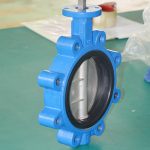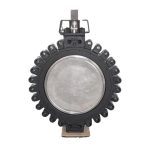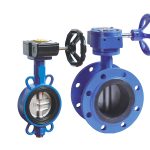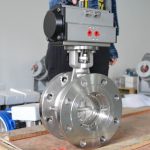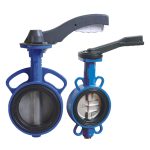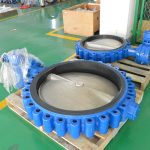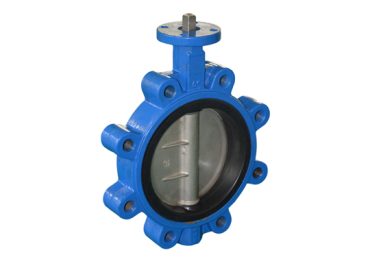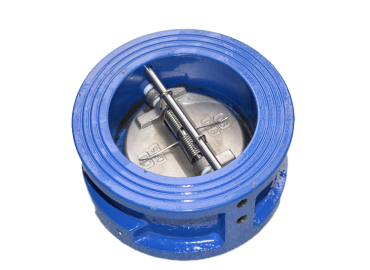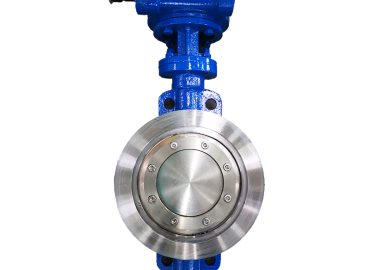Motorized butterfly valves are increasingly popular in fluid control systems due to their ability to provide precise control over fluid flow rates. An electric motor actuator controls the valve’s opening and closing, allowing for accurate positioning of the disc and smooth adjustment of the flow rate. This level of precision is particularly important in industries such as water treatment, chemical processing, and oil and gas pipelines, where even small variations in flow rate can have significant impacts on efficiency and safety. This article will explore how the motorized butterfly valve movement enables precise control over a fluid’s flow rate and its applications across various industries.
Introduction
The motorized butterfly valve movement enables precise control over fluid flow rate by allowing for accurate positioning of the disc, which regulates the flow of fluid through the valve. Electric actuators control the opening and closing of the valve, providing variable speed control for smooth and accurate adjustment of the flow rate. This level of precision is particularly important in industries such as water treatment, where small variations in flow rate can impact efficiency and quality of water output. The automated control systems of motorized butterfly valves also allow for remote operation and monitoring, improving efficiency and reducing labor costs. Feedback systems can be integrated to provide real-time monitoring and adjustment of the flow rate, ensuring that the valve is functioning optimally. Customization options are also available, allowing for specific application requirements to be met. For example, some valves may require fail-safe features or explosion-proof options. Overall, the motorized butterfly valve movement provides a reliable and energy-efficient solution for precise flow control across various industries.
Brief overview of butterfly valves and their importance in fluid control systems
Butterfly valves are an essential component in fluid control systems, used to regulate the flow of fluids through pipes and conduits. They are quarter-turn valves that consist of a flat circular disk, or “butterfly”, mounted on a rod. When the valve is closed, the disk is perpendicular to the flow path, blocking the fluid flow. When the valve is open, the disk is parallel to the flow path, allowing for fluid to pass through. Unlike other types of valves, butterfly valves have a low-pressure drop, meaning they don’t impede fluid flow as much. This feature makes them ideal for large-scale applications such as water treatment plants, oil refineries, chemical processing facilities, and many others. Additionally, butterfly valves are relatively simple to operate, require little maintenance, and can be automated with electric or pneumatic actuators for remote operation and monitoring
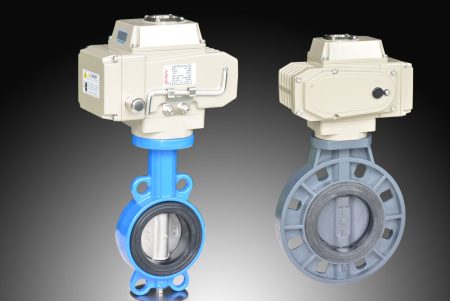
The need for precise control over fluid flow rate in various industries
Precise control over fluid flow rate is essential in various industries as it can impact the efficiency, safety, and quality of products being produced. In industries such as chemical processing, precise control over flow rate ensures that the correct amount of reagents is added at the right time, preventing unwanted reactions or inefficient chemical processes. In water treatment plants, accurate flow control is critical to ensure that the desired level of water purity is maintained. In oil and gas pipelines, precise flow control helps maintain desired pressure levels and prevent leakage. Additionally, precise control over flow rate can help in reducing energy costs and improving system performance. For these reasons, having a reliable and accurate flow control system is crucial in ensuring optimal operations in various industries.
Introducing the motorized butterfly valve as a solution for accurate flow control
Theized butterfly valve is an innovative solution for accurate flow control, providing a reliable and energy-efficient option for regulating fluid flow. With an electric actuator, the motorized butterfly valve can precisely position the disc, allowing for smooth and accurate adjustment of the flow rate. This precise control enables industries to optimize their operations while maintaining the desired level of efficiency, quality, and safety. Motorized butterfly valves are also relatively low maintenance, reducing labor costs and increasing productivity. As automation continues to gain importance in fluid control systems, motorized butterfly valves are quickly becoming the valve of choice for many industries due to their ability to provide accurate and reliable flow control.
Understanding Butterfly Valves
Butterfly valves are quarter-turn valves used to regulate the flow of fluids in pipes and conduits. They consist of a flat circular disc or “butterfly” that is mounted on a rod. When the valve is fully open, the disc is parallel to the flow path, allowing for full fluid flow. When the valve is closed, the disc is perpendicular to the flow path, blocking fluid flow. Butterfly valves are simple and easy to operate, making them an ideal choice for many industries. There are four main components of a butterfly valve: body, disc, stem, and actuator. The body is the main housing of the valve, which connects to the pipeline. The disc, also known as the butterfly, is the main component that controls the flow of fluid through the valve. The stem connects the disc to the actuator, which is responsible for controlling the motion of the disc. The actuator can be manual, pneumatic, hydraulic, or electric (motorized).
Manual butterfly valves are operated by hand through a lever or gear. Pneumatic butterfly valves use compressed air to move the disc, while hydraulic butterfly valves use liquid under pressure. Electric or motorized butterfly valves use an electric motor to control the motion of the disc, providing precise control over the flow rate. Motorized butterfly valves are becoming increasingly popular due to their accurate positioning capabilities, which enable smooth and reliable flow control.
Butterfly valves have a low-pressure drop, meaning they don’t impede fluid flow as much as other types of valves. This feature makes them ideal for large-scale applications, such as water treatment plants, oil refineries, and chemical processing facilities, where high flow rates are required. Additionally, butterfly valves require little maintenance, are easy to install, and are relatively low cost compared to other valve types. Overall, butterfly valves are an essential component in fluid control systems, providing efficient and reliable flow control in various industries.
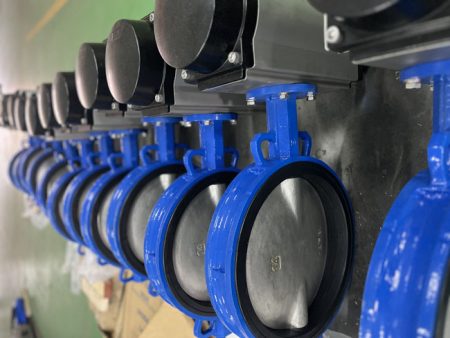
Basic components of a butterfly valve (body, disc, stem, and actuator)
The four basic components of a butterfly valve are the body, disc, stem, and actuator. The body is the main housing of the valve that connects to the pipeline and contains the other components. The disc, also known as the butterfly, is the circular component that controls the flow of fluid through the valve. The disc pivots on a shaft attached to the stem, which connects to the actuator. The stem is responsible for transmitting the motion from the actuator to the disc, moving it to either open or close the valve. Lastly, the actuator is the mechanism that controls the motion of the disc, enabling precise adjustment of the flow rate. The actuator can be manual, pneumatic, hydraulic, or electric (motorized). The type of actuator used will depend on the specific application requirements. Each component of a butterfly valve plays an important role in regulating fluid flow, making it a reliable and efficient solution for various industries.
How butterfly valves work: disc rotation and fluid flow regulation
Butterfly valves work by using a circular disc, or “butterfly”, to control the flow of fluid through a pipeline. When the valve is fully open, the disc is parallel to the flow path, allowing for full fluid flow. When the valve is closed, the disc is perpendicular to the flow path, blocking fluid flow. By rotating the disc partially, the flow rate can be adjusted smoothly and precisely. The disc is connected to a stem, which is connected to an actuator that controls the rotation of the disc. As the actuator moves the stem, the disc rotates, allowing for variable flow regulation. Unlike other types of valves, butterfly valves have a low-pressure drop, meaning they do not impede fluid flow as much, making them ideal for high flow rate applications. Butterfly valves are used in various industries, including water treatment plants, chemical processing facilities, and gas pipelines, where precise flow control is essential.
Common types of butterfly valves (manual, pneumatic, hydraulic, and motorized)
There are four common types of butterfly valves: manual, pneumatic, hydraulic, and motorized. Manual butterfly valves are operated by hand through a lever or gear, and they are the most basic type of butterfly valve. Pneumatic butterfly valves use compressed air to move the disc, making them more efficient than manual butterfly valves. Hydraulic butterfly valves use liquid under pressure to operate the valve, making them ideal for high-pressure applications. Motorized butterfly valves, also known as electric butterfly valves, use an electric motor to control the motion of the disc, providing precise and accurate positioning capabilities. Motorized butterfly valves are becoming increasingly popular due to their ability to provide reliable flow control while also reducing labor costs. The type of butterfly valve used will depend on the application requirements. For example, manual butterfly valves may be sufficient for small-scale applications, while motorized butterfly valves may be necessary for large-scale applications where precise control is critical. Overall, the different types of butterfly valves offer versatility and adaptability to suit various industries’ specific needs.
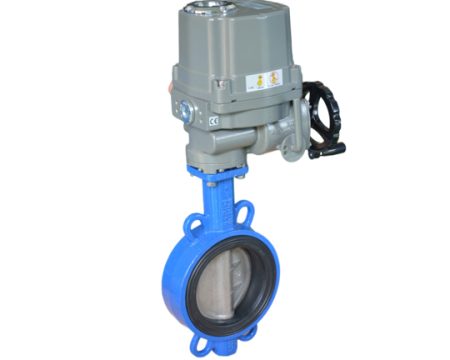
Motorized Butterfly Valves: Key Features
Motor butterfly valves, also known as electric butterfly valves, are a popular choice for industries that require precise control over fluid flow rates. One of the key features of motorized butterfly valves is their ability to provide accurate and reliable positioning capabilities. The electric motor in the actuator can precisely move the disc to the desired position, allowing for smooth and consistent flow control. This precise adjustment helps optimize operations, improves product quality, and reduces costs. Another key feature of motorized butterfly valves is their low maintenance requirements. Because the valve can be operated remotely, it reduces the need for manual labor, leading to reduced labor costs and increased productivity. The valve’s electric components can also be monitored and diagnosed remotely, allowing for quick identification and resolution of any issues.
Motorized butterfly valves are also energy-efficient, requiring less power to operate compared to other types of valves. Because the valve’s disc is lightweight and requires minimal force to adjust, the actuator uses less energy than other types of valves. This energy efficiency can result in significant cost savings over time, making motorized butterfly valves an attractive option for businesses looking to reduce energy consumption. Finally, motorized butterfly valves are easy to install and compatible with various pipe sizes, making them versatile and adaptable to different applications. With their precise control, low maintenance requirements, energy efficiency, and versatility, motorized butterfly valves are quickly becoming the valve of choice for many industries.
Actuators: electric motors that control the valve’s opening and closing
Actuators are an essential component of butterfly valves, particularly motorized butterfly valves. Actuators are electric motors that control the valve’s opening and closing, allowing for precise flow regulation. The actuator is connected to the stem, which transmits the motion from the motor to the disc. As a result, the disc can be precisely positioned to control fluid flow rates.Electric actuators are preferred for motorized butterfly valves due to their accuracy and precision. They can quickly and accurately adjust the valve’s position, providing smooth flow control with unprecedented accuracy and repeatability. This precise control enables industries to optimize their operations while maintaining the desired level of efficiency, quality, and safety.
Actuators also make it possible to automate valve control, reducing the need for manual labor. With automated control, valve operations can be easily monitored and adjusted as needed, leading to increased productivity and reduced labor costs. Additionally, electric actuators are reliable and require minimal maintenance, leading to increased uptime and fewer service interruptions.Overall, electric actuators are a critical component of motorized butterfly valves, providing precise and efficient control over fluid flow rates. With their ability to automate valve control, reduce manual labor requirements, and minimize downtime, electric actuators are becoming an increasingly popular option in various industries.
Precise positioning of the disc for accurate flow control
Precise positioning of the disc is crucial for accurate flow control in butterfly valves. The disc’s position determines the amount of fluid that can pass through the valve, making it essential to ensure proper positioning. With motorized butterfly valves, electric actuators provide the ability to position the disc with unprecedented accuracy and consistency, allowing for precise flow control. The electric motor in the actuator can adjust the valve’s disc position quickly and accurately, providing smooth and reliable flow control. Accurate flow control is particularly important in industries where product quality and safety are critical. Motorized butterfly valves provide precise control over the fluid flow rate, making them an ideal choice for applications that require tight process control. The ability to achieve accurate flow control enables businesses to optimize their operations, reduce waste, and improve product quality, ultimately leading to increased profitability and customer satisfaction.
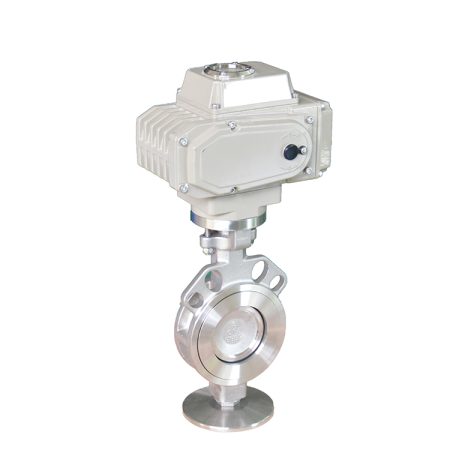
Automated control systems for remote operation and monitoring
Automated control systems are a crucial aspect of modern industrial processes, including those that incorporate butterfly valves. Automated control systems for motorized butterfly valves allow for remote operation and monitoring, reducing the need for manual labor and increasing productivity. With automated control systems, valve operations can be remotely monitored from a central location, providing real-time data on flow rates, pressure, and other critical parameters. This allows for quick identification and resolution of any issues, reducing downtime and ensuring maximum uptime.
Automated control systems also provide precise control over valve positioning, allowing for consistent and accurate flow regulation. The system can be programmed to adjust the valve’s position according to specific parameters, such as flow rate or pressure, enabling the valve to respond automatically to changes in the process. Additionally, automated control systems can be integrated with other process equipment, such as sensors and controllers, for improved overall process control.Overall, automated control systems for motorized butterfly valves provide a wide range of benefits, including reduced labor costs, increased productivity, improved process control, and reduced downtime. These benefits make it an ideal solution for industries that require precise flow control and reliable valve operation.
Benefits of using motorized butterfly valves (energy efficiency, low maintenance, and reduced labor costs)
Motor butterfly valves offer several benefits over other types of valves. One major benefit is their energy efficiency. Compared to other types of valves, motorized butterfly valves require less power to operate due to the lightweight disc and minimal force required to adjust the valve. This results in lower energy consumption and cost savings over time. Another benefit of motorized butterfly valves is their low maintenance requirements. Because the valve’s electric components can be monitored and diagnosed remotely, any issues can be quickly identified and resolved, reducing downtime and maintenance costs. Additionally, with automated control systems, valve operations can be remotely monitored, reducing the need for manual labor.
Finally, motorized butterfly valves are easy to install and compatible with various pipe sizes, making them versatile and adaptable to different applications. The precise control provided by motorized butterfly valves helps optimize operations, improve product quality, and reduce costs while maintaining safety. Overall, the benefits of motorized butterfly valves make them an attractive choice for industries looking to reduce energy consumption, maintenance costs, and labor requirements while improving valve performance, process control, and overall productivity.
How Motorized Butterfly Valve Movement Enables Precise Control
Motorized butterfly valves are an excellent example of how technology enables precise control in industrial applications. The movement of the valve’s disc is controlled by an electric actuator, which provides precision and accuracy in disc positioning. The actuator can quickly and accurately move the disc to the desired position, enabling precise control over fluid flow rates. This precise control allows for optimization of operations, improved product quality, and reduction in costs. The electric actuator in motorized butterfly valves utilizes a feedback mechanism to ensure accurate positioning of the valve’s disc. The feedback mechanism uses sensors to detect the valve’s position, providing real-time data on its location. This data is used to adjust the valve’s position as needed, providing precise control over the fluid flow rate. The feedback mechanism also ensures that the valve remains in the correct position, even when subjected to external forces or variations in process conditions.
The ability to achieve precise control over fluid flow rates with motorized butterfly valves is particularly valuable in industries where product quality and safety are critical. The precise control provided by motorized butterfly valves ensures that process parameters remain within a specified range, reducing the likelihood of process deviations and product defects. Additionally, the precise control reduces the risk of accidents, spills, and other safety hazards, enhancing overall workplace safety. Another benefit of motorized butterfly valves is their ability to respond quickly to changes in process conditions. With automated control systems, the valve can be programmed to adjust its position in response to changes in flow rate, pressure, or other parameters, ensuring that the process remains within a specified range. This ability to respond quickly to changes in process conditions helps optimize operations, reduce waste, and improve product quality.
Electric butterfly valve offer additional benefits, such as energy efficiency and low maintenance requirements. Compared to other types of valves, motorized butterfly valves require less power to operate due to the lightweight disc and minimal force required to adjust the valve. This results in lower energy consumption and cost savings over time. Additionally, with automated control systems, valve operations can be remotely monitored, reducing the need for manual labor and maintenance. Overall, motorized butterfly valves’ precise control capabilities make them an ideal choice for various industries that require tight process control and reliability. The ability to achieve precise control over fluid flow rates, respond quickly to process changes, and maintain workplace safety, energy efficiency, and low maintenance requirements makes motorized butterfly valves a valuable asset to any industrial process.
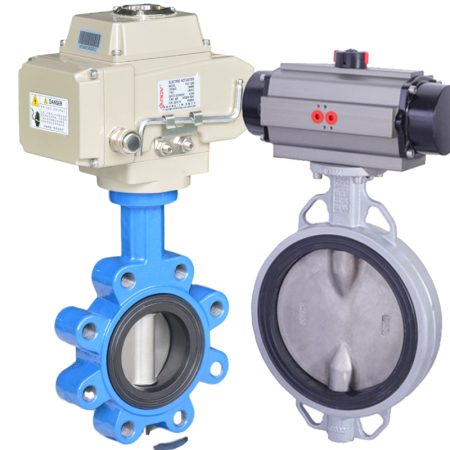
The role of electric actuators in precise disc positioning
Electric actuators play a crucial role in achieving precise disc positioning in motorized butterfly valves. The actuator motor is responsible for controlling the movement of the valve’s disc, enabling precise control over fluid flow rates. Through the use of sensors and feedback mechanisms, electric actuators can accurately measure the valve’s position and adjust it as needed, ensuring that the valve remains within a specified range.
One advantage of electric actuators is their ability to move the valve’s disc quickly and accurately. This fast response time enables precise control over fluid flow rates and allows the valve to respond to changes in process conditions. Additionally, the accurate position feedback provided by electric actuators ensures that the valve remains in the correct position, even when subjected to external forces or variations in process conditions.
Electric actuators also offer increased reliability and reduced maintenance requirements compared to other types of actuators. With no need for hydraulic fluids or air compressors, electric actuators require minimal maintenance and have a longer service life. Additionally, automated control systems incorporating electric actuators can remotely monitor the valve’s performance, reducing the need for manual labor and increasing productivity. Overall, the role of electric actuators in precise disc positioning is vital to achieving precise control over fluid flow rates in motorized butterfly valves. Electric actuators enable quick and accurate movement of the valve’s disc while providing reliable and low-maintenance operation. This precise control helps optimize operations, improve product quality, reduce costs, and maintain workplace safety.
Variable speed control for smooth and accurate adjustment of flow rate
Variable speed control is an essential feature of motorized butterfly valves that enables smooth and accurate adjustment of flow rate. The electric actuator in motorized butterfly valves allows the valve to be positioned at various angles, which controls the flow rate through the valve. By adjusting the valve’s position, fluid flow rates can be precisely controlled to optimize process performance and ensure product quality.
The variable speed control feature of motorized butterfly valves allows for a smooth and gradual adjustment of the valve’s position, ensuring that the flow rate changes are gradual and accurate. This precise control enables operators to maintain process parameters within a specified range, reducing the likelihood of process deviations and product defects. Additionally, the ability to adjust the flow rate smoothly and accurately reduces wear and tear on the valve, increasing its service life and reducing maintenance requirements.
Another benefit of variable speed control is that it provides better energy efficiency compared to other types of valves. The precise control over flow rate enables the system to operate at lower power levels, reducing energy consumption and cost savings over time. Additionally, the smooth and accurate adjustment of the valve’s position reduces turbulence in the fluid flow, reducing energy losses due to friction and improving overall system efficiency. Overall, the variable speed control feature of motorized butterfly valves is a valuable asset to industries that require precise control over fluid flow rates. The ability to adjust flow rates smoothly and accurately helps optimize process performance, reduce waste, improve product quality, increase energy efficiency, and reduce maintenance requirements.
Integration with feedback systems for real-time monitoring and adjustments
Integration with feedback systems is an essential feature of motorized butterfly valves that enables real-time monitoring and adjustments. The feedback system uses sensors to detect the valve’s position, providing real-time data on its location and performance. This data is used to adjust the valve’s position as needed, providing precise control over the fluid flow rate.
By integrating with feedback systems, motorized butterfly valves can be monitored remotely, reducing the need for manual labor and increasing productivity. The feedback system can quickly identify and diagnose any issues with the valve’s performance, reducing downtime and maintenance costs. Additionally, the ability to monitor the valve’s performance in real-time enables operators to optimize process parameters and ensure product quality.
Another benefit of integration with feedback systems is that it provides enhanced safety and reliability. The feedback system ensures that the valve remains in the correct position, even when subjected to external forces or variations in process conditions. This reduces the risk of accidents, spills, and other safety hazards, enhancing overall workplace safety.Overall, integration with feedback systems is a critical component of motorized butterfly valves that enables precise control, real-time monitoring, and adjustments. The ability to monitor the valve’s performance remotely and make adjustments as needed helps optimize operations, improve product quality, reduce costs, and maintain workplace safety.

Customization options for specific application requirements
Motor butterfly valves offer a variety of customization options that enable them to be tailored to specific application requirements. These customization options allow for the selection of materials, sizes, and features that best fit the needs of the application.One customization option is the choice of materials used in valve construction. Different materials offer varying degrees of resistance to corrosion, wear, and other factors that can affect performance. Choosing the right materials can help extend the valve’s service life and minimize maintenance requirements.
Another customization option is the size of the valve. Motorized butterfly valves are available in various sizes, making them adaptable to different pipe sizes and flow rates. Selecting the appropriate valve size is essential to achieving precise control over fluid flow rates and optimizing process performance.Additional customization options include selecting the type of electric actuator, the type of feedback system, and the degree of automation required. These options can be tailored to the specific requirements of the application, providing enhanced flexibility and control.
Overall, the customization options available for motorized butterfly valves enable them to be tailored to specific application requirements, ensuring optimal performance and reliability. By selecting the appropriate materials, sizes, and features, the valve can be optimized to meet the specific needs of the application, reducing downtime, improving product quality, and increasing overall productivity.
Applications of Motorized Butterfly Valve function in Various Industries
Motorized butterfly valves are widely used in various industries that require precise control over fluid flow rates. One such industry is the chemical industry, where motorized butterfly valves are used for controlling the flow of chemicals in various processes. The precise control provided by these valves ensures that chemicals are delivered in the correct quantities, reducing the likelihood of costly process deviations and product defects.
The pharmaceutical industry also extensively uses motorized butterfly valves to maintain precise control over fluid flow rates. These valves are essential in drug production, where precise control is vital to ensure product quality and safety. Additionally, motorized butterfly valves help reduce contamination risks and prevent cross-contamination, making them an invaluable asset in maintaining product quality and patient safety.
Motorized butterfly valves are also used in the water treatment industry for applications such as flow regulation, backwash filtration systems, and chemical dosing. In these applications, the precise control provided by these valves ensures that water treatment processes remain within a specified range, reducing waste, optimizing operations, and improving overall system efficiency.The food and beverage industry also extensively uses motorized butterfly valves for controlling fluid flow rates in various processes such as brewing, dairy processing, and bottling. The precise control offered by these valves ensures consistent product quality, reduces waste, and minimizes downtime due to maintenance or repairs.
In the oil and gas industry, motorized butterfly valves are used for controlling the flow of various liquids and gases in pipelines and refineries. The precise control offered by these valves ensures that the products are delivered in the correct quantities, optimizing operations and reducing costs. Additionally, motorized butterfly valves help maintain workplace safety in hazardous environments, enhancing overall safety and reliability.Overall, motorized butterfly valves offer precise control over fluid flow rates, making them an ideal choice for various industries that require tight process control and reliability. The ability to achieve precise control over fluid flow rates, respond quickly to process changes, maintain workplace safety, and customize the valve to specific application requirements makes motorized butterfly valves a valuable asset to any industrial process.

Water and wastewater treatment plants
Water and wastewater treatment plants use motorized butterfly valves for various applications, including flow regulation, backwash filtration systems, and chemical dosing. In water treatment plants, the precise control provided by motorized butterfly valves ensures that water treatment processes remain within a specified range, reducing costs, optimizing operations, and improving overall system efficiency. Additionally, motorized butterfly valves are used in backwash filtration systems to control the flow of water through the filter media, ensuring that the filter is cleaned thoroughly and efficiently.
In wastewater treatment plants, motorized butterfly valves are used for various applications, including flow regulation in influent and effluent streams, controlling the flow of chemicals in the treatment process, and controlling the flow of sludge. The precise control provided by these valves ensures that wastewater treatment processes remain within a specified range, minimizing the risk of process deviations and product defects. Additionally, motorized butterfly valves help reduce contamination risks and prevent cross-contamination, making them an invaluable asset in maintaining product quality and ensuring public health and safety.
Overall, motorized butterfly valves play a crucial role in water and wastewater treatment plants by providing precise control over fluid flow rates. The ability to achieve precise control over fluid flow rates enables operators to optimize operations, improve product quality, reduce costs, and maintain workplace safety. With customizations available to meet specific application requirements, motorized butterfly valves are a valuable asset to any water or wastewater treatment plant.
Oil and gas pipelines
Oil and gas pipelines use motorized butterfly valves for controlling the flow of various liquids and gases through the pipeline. The precise control offered by these valves ensures that the products are delivered in the correct quantities, optimizing operations and reducing costs. Additionally, motorized butterfly valves help maintain workplace safety in hazardous environments, enhancing overall safety and reliability. In addition to providing precise control over fluid flow rates, motorized butterfly valves also offer customization options that make them adaptable to the specific needs of oil and gas pipelines. These customizations include the choice of materials used in valve construction, the size of the valve, the type of electric actuator, and the degree of automation required. By selecting the appropriate materials, sizes, and features, the valve can be optimized to meet the specific needs of the pipeline, reducing downtime, improving product quality, and increasing overall productivity.
Chemical processing facilities
Chem processing facilities use motorized butterfly valves for various applications, including controlling the flow of chemicals in various processes. The precise control provided by these valves ensures that chemicals are delivered in the correct quantities, reducing the likelihood of costly process deviations and product defects. Additionally, motorized butterfly valves help reduce contamination risks and prevent cross-contamination, making them an invaluable asset in maintaining product quality and workplace safety. Chemical processing facilities also benefit from the customization options available with motorized butterfly valves. These customizations include the choice of materials used in valve construction, the size of the valve, the type of electric actuator, and the degree of automation required. By selecting the appropriate materials, sizes, and features, the valve can be optimized to meet the specific needs of the facility, reducing downtime, improving product quality, and increasing overall productivity. Overall, motorized butterfly valves play a crucial role in chemical processing facilities by providing precise control over fluid flow rates, minimizing risks, and optimizing operations.
HVAC systems in buildings
HVAC (Heating, Ventilation, and Air Conditioning) systems in buildings use motorized butterfly valves for various applications, including controlling the flow of air and water through the system. The precise control offered by these valves ensures that the temperature and humidity of each room are maintained within a specified range, providing optimal comfort to the occupants of the building. Motorized butterfly valves help reduce energy consumption by ensuring that heating and cooling systems only operate when required, reducing energy waste and costs. Additionally, motorized butterfly valves help maintain indoor air quality by ensuring proper ventilation and filtering of air. By using customizations such as selecting the appropriate materials and sizes, motorized butterfly valves can be optimized to meet the specific needs of different HVAC systems in buildings, ensuring reliable and efficient performance. Overall, motorized butterfly valves play a critical role in maintaining optimal conditions in HVAC systems, providing comfort to occupants, reducing energy consumption, and improving indoor air quality.
Food and beverage production lines
Food and beverage production lines use motorized butterfly valves for various applications, including controlling fluid flow rates in various processes such as brewing, dairy processing, and bottling. The precise control offered by these valves ensures consistent product quality, reduces waste, and minimizes downtime due to maintenance or repairs. Additionally, motorized butterfly valves help reduce contamination risks and prevent cross-contamination, making them an invaluable asset in maintaining product quality and ensuring public health and safety. Food and beverage production lines also benefit from the customization options available with motorized butterfly valves. These customizations include the choice of materials used in valve construction, the size of the valve, the type of electric actuator, and the degree of automation required. By selecting the appropriate materials, sizes, and features, the valve can be optimized to meet the specific needs of the production line, reducing downtime, improving product quality, and increasing overall productivity. Overall, motorized butterfly valves play a crucial role in food and beverage production lines by providing precise control over fluid flow rates, minimizing risks, and optimizing operations.
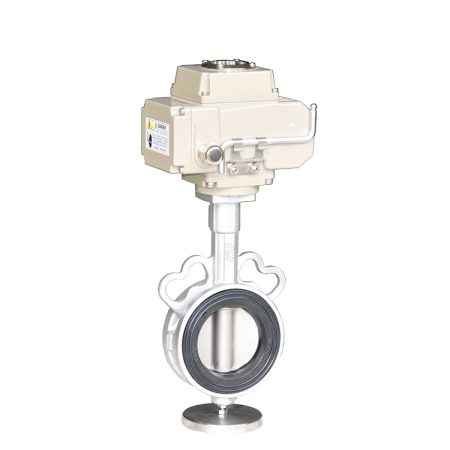
Factors to Consider When Choosing a Motorized Butterfly Valve function
When choosing a motorized butterfly valve for a specific application, several factors must be considered to ensure optimal performance, reliability, and efficiency. One of the primary factors is the type of fluid being controlled, as different fluids may require valves made from specific materials to prevent corrosion or contamination. For example, food and beverage production lines may require stainless steel valves to maintain sanitary conditions, while chemical processing facilities may need valves made from materials that can withstand aggressive chemicals.
Another essential factor to consider is the size of the valve, which should match the pipe diameter to ensure proper flow control and minimize pressure loss. The choice of the electric actuator is also crucial, as it directly affects the valve’s response time, precision, and overall performance. The actuator should be selected based on the torque requirements of the valve and the desired level of automation.
The degree of automation required for the specific application is another important consideration. Some applications may require manual override capabilities, while others may benefit from more advanced automation features such as remote control, programmable setpoints, and integration with building management systems or industrial control systems.The operating conditions, such as temperature, pressure, and flow rate, must also be taken into account when selecting a motorized butterfly valve. Valves should be chosen based on their ability to withstand the specific operating conditions of the application, ensuring long-term reliability and performance. For example, high-temperature applications may require valves with heat-resistant materials and components, while high-pressure applications may necessitate valves with robust construction and reinforced seals.
Installation and maintenance requirements should also be considered when choosing a motorized butterfly valve. Valves should be easy to install and maintain, minimizing downtime and reducing overall costs. Additionally, the availability of spare parts and technical support should be factored in to ensure prompt repairs and replacements if necessary.Lastly, the cost of the motorized butterfly valve should be weighed against its performance, reliability, and longevity. While it may be tempting to opt for a lower-cost option, investing in a high-quality valve from a reputable manufacturer can provide better long-term value by reducing maintenance costs, minimizing downtime, and ensuring optimal performance throughout the valve’s lifespan. By carefully considering these factors, you can select the ideal motorized butterfly valve for your specific application, ensuring efficient and reliable control of fluid flow rates.
Valve size and pressure rating
Valve size and pressure rating are critical factors to consider when selecting a valve for a specific application. The valve size, which corresponds to the pipe diameter, should be chosen to ensure proper flow control and minimize pressure loss. A mismatch in valve size can lead to inefficiencies in the system, such as reduced flow rates or increased pressure drops, ultimately affecting the performance of the entire process. The pressure rating, on the other hand, indicates the maximum pressure the valve can withstand without compromising its integrity or functionality. It is essential to choose a valve with a pressure rating suitable for the application’s operating conditions, as an inadequate rating may cause the valve to fail under high-pressure situations, potentially leading to leaks, equipment damage, or even hazardous incidents. By carefully considering both valve size and pressure rating, you can select the appropriate valve for your specific needs, ensuring optimal performance, reliability, and safety in your fluid handling system.
Type of fluid being controlled
The type of fluid being controlled is a crucial factor to consider when selecting a valve for a specific application, as it directly impacts the valve’s materials, construction, and performance. Different fluids have varying properties such as viscosity, corrosiveness, and temperature sensitivity, which may require specialized valve designs or materials to ensure proper flow control and prevent contamination or degradation. For instance, valves used in chemical processing facilities must be made from materials resistant to aggressive chemicals, while those used in food and beverage production lines may require sanitary-grade stainless steel to maintain hygienic conditions. Additionally, certain fluids may necessitate the use of seals or gaskets with specific chemical compatibility to prevent leaks and ensure long-term reliability. By taking into account the type of fluid being controlled, you can select the most suitable valve for your application, ensuring optimal performance, durability, and safety in your fluid handling system.
Environmental conditions (temperature, humidity, and corrosive elements)
Environmental conditions, such as temperature, humidity, and corrosive elements, play a vital role in determining the appropriate valve selection for a specific application. These factors can significantly impact the performance, durability, and overall lifespan of a valve, making it essential to consider them when selecting materials and components. For example, high-temperature applications may require valves made from heat-resistant materials and components to ensure reliable operation under extreme conditions. Similarly, in humid or corrosive environments, valves constructed from corrosion-resistant materials, such as stainless steel or specialized alloys, are necessary to prevent premature wear and failure. Furthermore, seals and gaskets within the valve must be compatible with the environmental conditions and resist degradation due to temperature fluctuations, moisture, or corrosive substances. By carefully considering the environmental conditions in which the valve will operate, you can select the most suitable materials and components to ensure optimal performance, reliability, and longevity in your fluid handling system.
Required level of precision in flow control
The required level of precision in flow control is an essential factor to consider when selecting a valve for a specific application. Different processes and industries demand varying degrees of accuracy in flow regulation, which directly impacts the choice of valve type, actuator, and control features. For instance, certain critical applications, such as pharmaceutical manufacturing or chemical processing, may necessitate a high degree of precision to ensure consistent product quality and maintain stringent safety standards. In such cases, selecting a valve with accurate and responsive flow control capabilities, coupled with a reliable and precise actuator, is crucial. Furthermore, advanced control features, such as programmable setpoints, remote control, and integration with process control systems, can significantly enhance the level of precision and automation in flow control. By carefully considering the required level of precision for your specific application, you can select the most suitable valve and control features, ensuring optimal performance, efficiency, and safety in your fluid handling system.
Compatibility with existing control systems
Compatibility with existing control systems is a vital factor to consider when selecting a valve for a specific application. Integration of the valve into the current infrastructure, such as building management systems, industrial control systems, or process automation systems, is crucial for seamless operation and efficient flow control. Choosing a valve that supports common communication protocols, such as Modbus, HART, or Profibus, ensures easy integration and interoperability with the existing control systems. Furthermore, compatibility with the control system enables advanced features like remote monitoring and control, data logging, and real-time adjustments, which can significantly enhance the overall performance, efficiency, and safety of the fluid handling system. By carefully considering the compatibility of the valve with your existing control systems, you can ensure a smooth and seamless integration, optimizing the operation and management of your fluid handling processes.

Conclusion
In conclusion, motorized butterfly valves have revolutionized fluid flow control by providing a high level of precision and automation in various applications across multiple industries. Their unique design and movement enable them to regulate fluid flow rates effectively, ensuring optimal performance, efficiency, and safety in fluid handling systems.The key to the precise control offered by motorized butterfly valves lies in their design, which features a centrally-mounted disc that rotates within the valve body. This disc, or butterfly, can be positioned at various angles to adjust the flow area, allowing for fine-tuned regulation of the fluid’s flow rate. The electric actuator, which drives the disc’s rotation, further enhances the precision of the valve by offering accurate and responsive control over the disc’s position.
Moreover, the advanced features and capabilities of modern electric actuators contribute significantly to the precise control provided by motorized butterfly valves. These actuators often come with programmable setpoints, remote control, and integration options with process control systems, enabling users to achieve precise flow control tailored to their specific application requirements. Furthermore, real-time adjustments can be made based on the monitored process parameters, ensuring consistent and accurate flow regulation.Another factor contributing to the precise control of fluid flow rates by motorized butterfly valves is their compatibility with existing control systems. Seamless integration into building management systems, industrial control systems, or process automation systems allows for centralized monitoring and control of the valves. This integration enables operators to make data-driven decisions and optimize the fluid handling system’s performance, ultimately enhancing the precision and efficiency of flow control.
Lastly, the reliability and durability of motorized butterfly valves also play a crucial role in maintaining precise flow control over time. By selecting valves made from high-quality materials and components, designed to withstand the specific operating conditions and environmental factors, users can ensure long-term reliability and performance. This reliability translates to consistent and accurate flow control, minimizing downtime and maximizing productivity in fluid handling processes.In summary, motorized butterfly valves offer precise control over fluid flow rates by combining their unique design and movement with advanced actuator features and seamless integration into control systems. This level of precision has made these valves an indispensable component in various industries, from chemical processing to water treatment, food and beverage production, and beyond. By carefully considering factors such as valve size, pressure rating, type of fluid, environmental conditions, and compatibility with existing control systems, users can select the ideal motorized butterfly valve for their specific application, ensuring efficient and reliable control of fluid flow rates.
Recap of how motorized butterfly valve function movement enables precise control over fluid flow rate
In recap, the motorized butterfly valve’s precise control over fluid flow rates is primarily attributed to its unique design, featuring a centrally-mounted disc that rotates within the valve body. This rotation enables fine-tuned regulation of the flow area, allowing for accurate flow rate adjustments. The electric actuator further enhances precision by providing responsive and accurate control over the disc’s position. Additionally, advanced actuator features, seamless integration with existing control systems, and the use of high-quality materials and components contribute to the valve’s reliability and performance, ensuring consistent and precise flow control in various fluid handling applications across multiple industries.
The advantages of using motorized butterfly valve function in various industries
The use of motorized butterfly valves in various industries offers numerous advantages, making them a preferred choice for fluid flow control applications. One significant benefit is their precise and automated flow control, enabled by the unique design of the rotating disc and advanced electric actuators. This precision results in improved efficiency, consistent product quality, and enhanced safety in processes ranging from water treatment to chemical processing, food and beverage production, and more. Another advantage is their compatibility with existing control systems, which allows for seamless integration and centralized monitoring and control, facilitating data-driven decision-making and optimization of fluid handling systems. Furthermore, motorized butterfly valves are known for their compact design and relatively lower cost compared to other valve types, making them an economical and space-saving solution for flow control. Lastly, their durability and reliability, achieved through the selection of high-quality materials and components, ensure long-term performance and minimize downtime, contributing to increased productivity and reduced maintenance costs in various industrial applications.
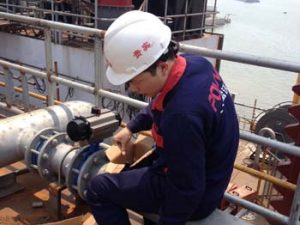
The importance of selecting the right valve for specific applications to ensure optimal performance
Selecting the right valve for specific applications is of paramount importance to ensure optimal performance, efficiency, and safety in fluid handling systems. The appropriate valve selection depends on several factors, including the type of fluid, operating pressure and temperature, required level of precision in flow control, environmental conditions, and compatibility with existing control systems. By carefully considering these factors, users can choose a valve that meets their specific requirements and effectively regulates the fluid flow rates. Choosing the correct valve not only enhances the overall performance of the system but also extends the valve’s lifespan, reduces maintenance costs, and minimizes downtime. Furthermore, a well-suited valve contributes to consistent product quality, adherence to safety standards, and improved energy efficiency, ultimately resulting in increased productivity and cost savings for various industries.




